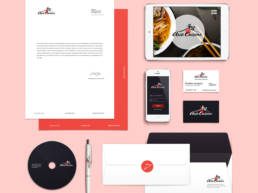Web Design
Web design and Support
A crisp, beautiful and functional website is essential in this digital time. Decem Studio provides you with a solid place on the web. We make it as easy as possible for you. From the hosting to the layout and maintenance of your site, that's all part of it. Everything of course in accordance with your corporate identity.
We can also provide more complex websites with e.g. quotation forms, databases or other applications. Of course SEO-friendly to ensure good search results.


Web Design
Web Support
E-commerce
Social Media management

WEBSITE DESIGN
Step 1: Discover
The “Discovery” phase of the web design process is to collect information. This is essential for you to learn more about your client’s business and industry, the target market and clients, and the website’s ultimate goal/objective.
Ask the client questions at this stage:
What does your business or organization do?
What makes your business or organization different from its competitors?
Who are your competitors?
Who is your ideal customer?
Describe the concept, project or service that this site is designed to provide or promote
Step 2: Plan
As well as gathering information, the stage of site design planning is an important part of the launch of a new site. As designers, it is easy to immediately wish to move to the phase of design development, as it is the most creative (and enjoyable) part of the project. But in the end, research and planning will help to clarify your goals for the site and direct your design, so spend a generous amount of time at this stage of the process. Spending time on site planning is a good investment that will ultimately save you time and even money in the long run.
Step 3: Design
The third stage of the web design process is the development of the design of what a website will look like. At this stage, a site frame is created with the main elements of the web page, such as title, navigation, widgets, etc. Then the framework can be moved to a more realistic layout using a program such as Photoshop.
The design should also accommodate the content. Content often accommodates design, and in the end very little attention is paid to the content. The content of the site – this is what you want viewers to notice the number one. For each page design, ask yourself these questions:
What is the main purpose of the page?
Is it clear to users, what actions they should take?
How does the design encourage users to take action?
Step 4: Develop
At the development stage the design of the site is transformed into real code that makes the site work. This stage may be the longest, so keep customers informed about the status of the project.
Such an email with 3 offers is perfect to keep in touch with the client:
it includes the main stages of site development:
Installing WordPress on your local host or test server.
Installation of WordPress start theme.
Install the WordPress backup plugin as BackupBuddy. Running the backup plugin during development makes it easy to 1) return changes to the file and 2) move the site to a live domain or server to run.
Using the layout, move the design to a live site.
Testing and optimization in progress.
Step 5: Launch
It’s finally time to launch the site. Since there are so many steps involved in launching the site, it is useful to use a checklist to make sure that you have not missed a single step.
Use these checklist messages to make sure that your site is running smoothly:
Step 6: Maintenance
This last and final stage of web design is often overlooked by freelancers, but site maintenance is important for the long-term health and success of the site, and as a source of potential recurring revenue.
Even before a new web project begins, it is necessary to educate potential customers about the long-term responsibilities of the site owner. Just as owning a car or house, a website needs maintenance and technical support. Just like owning a car or a house, a website will need maintenance and technical support. Offer monthly WordPress maintenance to get rid of your customers’ website maintenance tasks.
As a basic level, WordPress maintenance includes the following steps to keep your WordPress website running smoothly:
- WordPress Updates
- Theme and plugin updates
- WordPress Backups
- WordPress Security
- Analytics Tracking and Reporting
- WordPress Hosting
- Site corrections
- Changes in content and form
- Installation plug-ins
- Slight improvements
- Questions “How”
- Availability of site
- Website operation
- CMS and plugin updates
- Accommodation issues
WordPress service may also extend to other areas of the site, such as SEO, adding new content or updating existing content, approving/refreshing comments, cleaning up spam and much more.
Learn the full procedure of creating a website
We Offer
The site is a presentation of the company made for specific needs: interaction with customers, providing them with more detailed information about products and services, demonstration of cases and portfolios and much more. It is very important to hire professionals to implement the site in the entire digital ecosystem, including social media and online advertising.
Responsive Design
With the support we provide domain and hosting for the whole year, e-mail addresses for your domain and easy navigation on the site, looking good on all devices.
Intuitive workflow
Our sites are user-friendly and have an implementation of social media channels, and we provide our clients with tools for working with CMS systems for easy text editing.
Security
We back up and maintain the site, and we can provide reliable security features that will protect the site from spam and threats.










